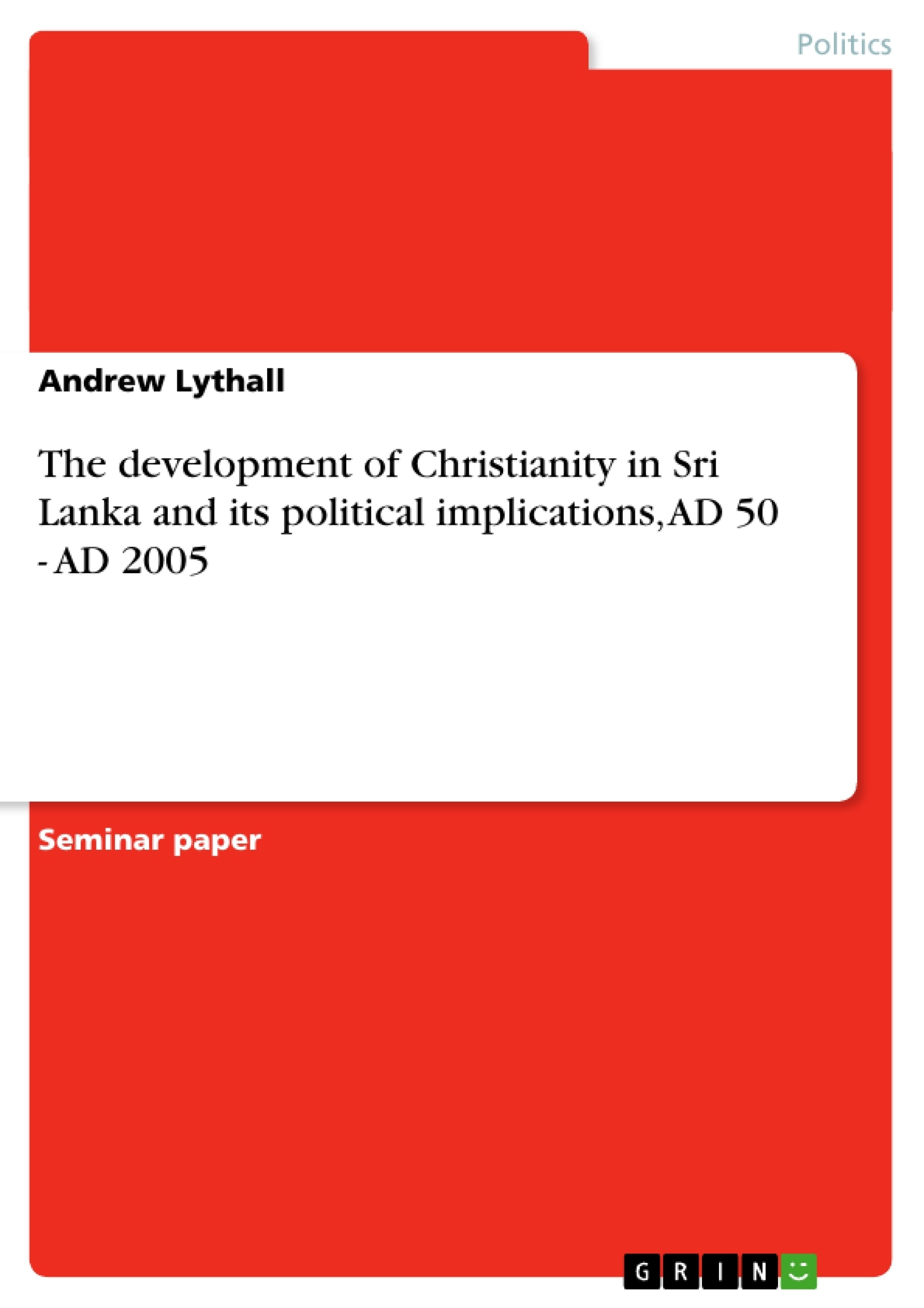The development of Christianity in Sri Lanka has been a long and complex process. Christianity has been instrumental in the development of modern Sri Lankan politics and culture. In this paper I will attempt to map the development of Christianity on the island and assess its resultant political implications. I will also attempt to prove that Christianity has played a major role in the political development of present day Sri Lankan democracy.
I. Background
Christian development in Sri Lanka could have started as early as AD c.50 when, according to legend, St. Thomas the Apostle set foot upon the island to preach the message of the gospels.1 Since then, Sri Lanka has experienced several stages of Christian development- which can be loosely mapped as a transition from Roman Catholicism to Modern Denominationalism- primarily orchestrated by the ruling power that happened to be enjoying occupation of the island at the time. Because each of these powers (namely the Portuguese, Dutch and British) attempted to impose their own brand of Christianity on the region and met with varying degrees of success, modern Sri Lankan Christianity is a rich tapestry of denominational beliefs including, in order of primacy, Catholicism (over 85%), Anglicanism, Dutch Reformism and Non- Conformism (including Baptists and American Congregationalists).2 The number of Christians in Sri Lanka is considerable; of 20,064,776 residents, 6.2% (roughly 1.25 million) consider themselves Christian (2001 census data).3 Furthermore, Christians comprised over 10.6% of the population during the high British colonial period (c.1900). Thus, as a large minority group, Christian development inherently affected- and still affects- the development of Sri Lankan politics as a whole. The study of such development is thus important in order to better understand the evolution of Sri Lankan society and politics, and the present political situation of Sri Lanka and its’ people.
II. Study
It is possible that St. Thomas the Apostle did actually preach in Sri Lanka. By tradition, it is alleged that he was killed in India, stabbed with a spear sometime around AD 72.4
1 Jones
2 De Sampayo
3 CIA World Factbook
4 Jones
Table of Contents
- I. Background
- II. Study
- Methods of Christianisation and conversion
- Christian ideology and values influenced other religious bodies and were generally accepted as good things
- Christianity as a socio-political catalyst
Objectives and Key Themes
This paper aims to examine the evolution of Christianity in Sri Lanka from its origins to the present day, analyzing its impact on the country's political and cultural development. The focus will be on demonstrating the significant role Christianity has played in shaping modern Sri Lankan democracy.
- The historical development of Christianity in Sri Lanka, from its early origins to the present day.
- The influence of different colonial powers (Portuguese, Dutch, and British) on the spread and evolution of Christianity in Sri Lanka.
- The methods employed for Christianization and conversion, including their impact on political and social attitudes.
- The emergence and role of the Burgher community as a socio-ethnic group shaped by Christian influence.
- The impact of Christianity on Sri Lankan society, particularly in education, traditions, and political development.
Chapter Summaries
I. Background: This section provides an overview of the historical development of Christianity in Sri Lanka. It establishes the significant presence of Christians as a minority group, highlighting its relevance to the study of Sri Lankan politics and society. The background section traces the origins of Christianity in Sri Lanka, citing the legend of St. Thomas the Apostle and discussing its impact on the island's cultural and religious landscape. It also mentions the arrival of Portuguese, Dutch, and British powers and their influence on the spread of Christianity, laying the groundwork for the subsequent analysis.
II. Study: This chapter delves deeper into the historical evidence regarding the early arrival of Christianity in Sri Lanka, focusing on the possibility of St. Thomas the Apostle's visit and the arrival of settlers from Syria and Persia. It examines the existing historical and literary evidence to assess the validity of the myth of St. Thomas and presents a more definitive timeline for the arrival of Christianity in Sri Lanka, establishing the Portuguese period as the significant turning point.
Methods of Christianisation and conversion: This chapter explores the different approaches employed by the Portuguese, Dutch, and British in spreading Christianity in Sri Lanka. It highlights the varying degrees of zeal and the resulting political and social consequences. The chapter examines how different ethnic groups reacted to Christianization, analyzing factors such as geography, political control, and social incentives that led to varying levels of acceptance or resistance. It also discusses the use of fiscal rewards and social benefits as tools for attracting converts, emphasizing the complex motivations behind conversion.
Christian ideology and values influenced other religious bodies and were generally accepted as good things: This section explores the broader impact of Christian ideology on other religious groups in Sri Lanka. It discusses how Christian values and ideas, particularly those related to work and sex, influenced the development of Buddhism, highlighting the interconnectedness of religious ideologies in the Sri Lankan context.
Keywords
The primary keywords associated with this work include: Sri Lanka, Christianity, colonialism, Portuguese, Dutch, British, Christianization, conversion, political development, social development, Burgher, ethnic groups, religious influences, Buddhism, and Sri Lankan democracy. This comprehensive analysis of the development of Christianity in Sri Lanka offers a deep understanding of the multifaceted nature of the island's socio-political history and the lasting impact of Christian influences.
- Quote paper
- Andrew Lythall (Author), 2005, The development of Christianity in Sri Lanka and its political implications, AD 50 - AD 2005, Munich, GRIN Verlag, https://www.grin.com/document/55239




